This post may contain affiliate links. This just means I may receive a small commission at no extra cost to you for helping them promote their product or service. I don’t endorse any services I don’t personally use or recommend.
A self-drivers guide to Samburu National Park and Buffalo Springs National Reserve, two hidden gems in Kenya’s North Central desert.
As we dynamited the brakes, inciting a cloud of feathery dust to engulf the car, swirling into each open window and coating us in a thin layer of powdery orange chalk, a herd of elephants swayed out of the bushes into the road. Some watched carefully from no more than 10 feet away, munching leaves from thick bushes. Samburu is a desert. Hot, windy, barren. But its wildlife is unique. Long-necked Gerenuk straining to reach the tallest branches, rare Reticulated Giraffe, blue-legged Somali Ostrich, elegant Beisa Oryx, and Grevy’s Zebra round out the “Samburu Five,” a collection of wildlife found only here within Kenya.
This is your guide to Samburu National Park and Buffalo Spring National Reserve, two of three connected parks in this region for wildlife enthusiasts and self-drivers. Shaba National Reserve is also here but contains far less wildlife than its neighbors.
Self Driver’s Guide to Samburu National Park (and Buffalo Springs National Reserve)
This national park is well off the beaten path. A full-day drive North of Nairobi, it’s too remote for most travelers to add to their jam-packed 5-to-7-day safaris. But self-drivers are different. With the flexibility offered only to those with their own wheels, you can easily add this park to your route through Kenya. Here’s our complete guide to Samburu National Park so you can plan your visit.
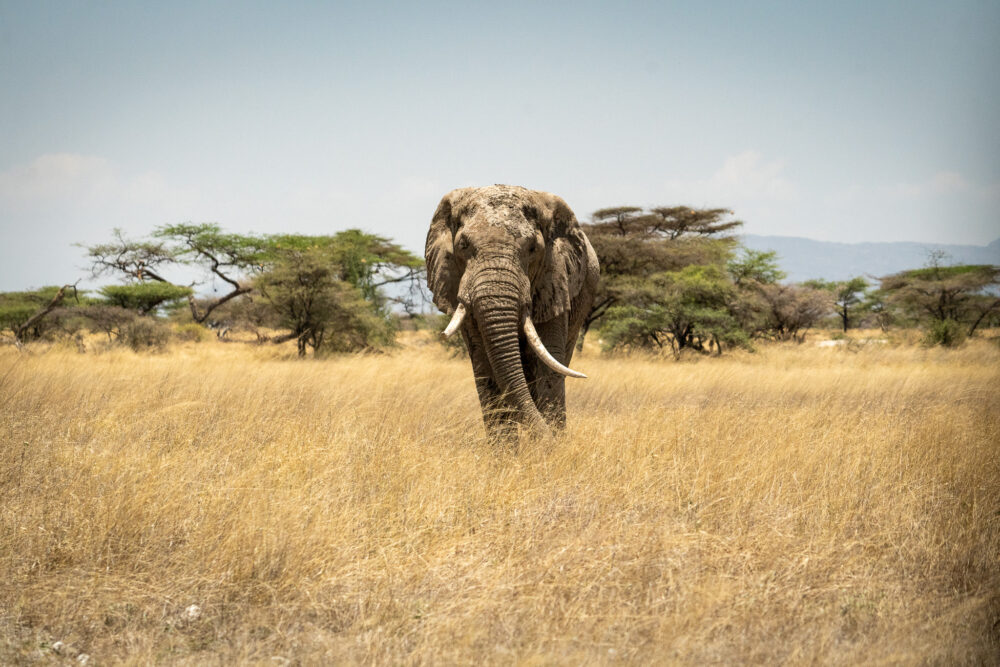
Getting to Samburu National Park
This is the best route to reach Samburu from Nairobi. It also passes by Ol Pejeta Conservancy— one of my favorite wildlife parks in East Africa.
LAST GAS STATION: Be conscious of your petrol level when approaching the park. While you can get bottled gasoline in Archers Post in a pinch, the last reputable station is in Isiolo. You’ll want to enter the parks with a full tank.
If you’re feeling like taking your time, I highly recommend leaving the highway behind and driving along the fence of Solio Conservancy (but still outside it’s boundaries) and then up through Borena Conservancy and Lewa Conservancy on your way to Samburu. Following this route, you’ll get to enter two parks totally for free and likely see a ton of wildlife, including Rhino! The road inside Borena isn’t great, but if you’re comfortable off-road, it’s totally doable.
Break Up the Journey – Where to Stay



You can break up the journey with an overnight at Sandai Guesthouse— a lovely campsite and guesthouse run by Petra, a German immigrant who has lived in Kenya for several decades. The property is brimming with wildlife and a particularly peaceful place to sleep. Camping is about $8, and she serves a family-style dinner for $10 a person.
Read More: A Self-Drive Itinerary for East Africa
Cost of Visiting Samburu & Buffalo Springs
As of 2024, you technically have to pay for each of these two parks separately. We visited Samburu National Park and exited through Buffalo Springs National Reserve with no problems, carrying only a Samburu Park Ticket. No promise it will work for you, though.
The park entrance fee is $70 per person for 24 hours. You will have to pay upon entry and with a credit card (not cash) when you arrive at the park. No need to pay for anything in advance of your visit.
Camping in Kenya’s parks typically costs around $35 for two people. But I’ll dig into your sleeping/camping options in the park in the “where to stay section below.”
This means for two people, it costs around $175 to visit Samburu National Park.
Read More: Is a Self-Drive Safari ACTUALLY Cheaper— A Cost Comparison
How Long to Stay When Visiting Samburu & Buffalo Springs
I recommend one night in each of these parks. You don’t need any more time than that, but in an ideal world, two full days.

Going on safari in East Africa is expensive. That’s why so many self-drivers limit their time in the parks. We ended up only doing one day and spending the majority in Samburu National Park.
If I Have to Choose Between the Parks… Which Should I Choose?
This is the tricky thing about visiting Samburu and Buffalo Springs. If you only have ONE day and must choose one park…I would choose Samburu. Probably.
Here is the argument for each.
Samburu is known to have better wildlife sightings. The park is much greener and generally prettier than Buffalo Springs as well. The species that stay in Samburu are far more varied than in Buffalo Springs.

On the other hand, Buffalo Springs is where we ACTUALLY found the most incredible wildlife, such as Gerenuk and Cheetah. We were told that during our visit, most of the predators had crossed the river into Buffalo Springs. Because they do go back and forth, there is no way to know which park will hold the big wildlife during your visit. Buffalo Springs also has a better public campsite near the idyllic crystalline namesake pool.


Where to Stay in Samburu National Park & Buffalo Springs
In Samburu, the public campsite is near the river, which seems ideal…but it is swarming with habituated baboons. They are constantly trying to steal your stuff and eat your food. Instead, we offered the nearby Samburu Riverside Lodge $20 to let us camp in their parking area. We got to use their facilities and enjoy shade and baboonless cooking.
Buffalo Springs has a great public campsite right next to the natural pool. This is a great place to stay during your time in the park.
Neither public campsites need to be reserved in advance. You will inform the rangers at the ticketing office when you enter that you plan to stay in them. You’ll pay the camping fee alongside your entrance fee upfront.
Best Areas Within Both Parks for Wildlife
You should always ask the rangers when you enter the park if there have been any good sightings lately, as the animals move around a lot here. During our time in the park, ALL the wildlife was present in this circled portion of Samburu.
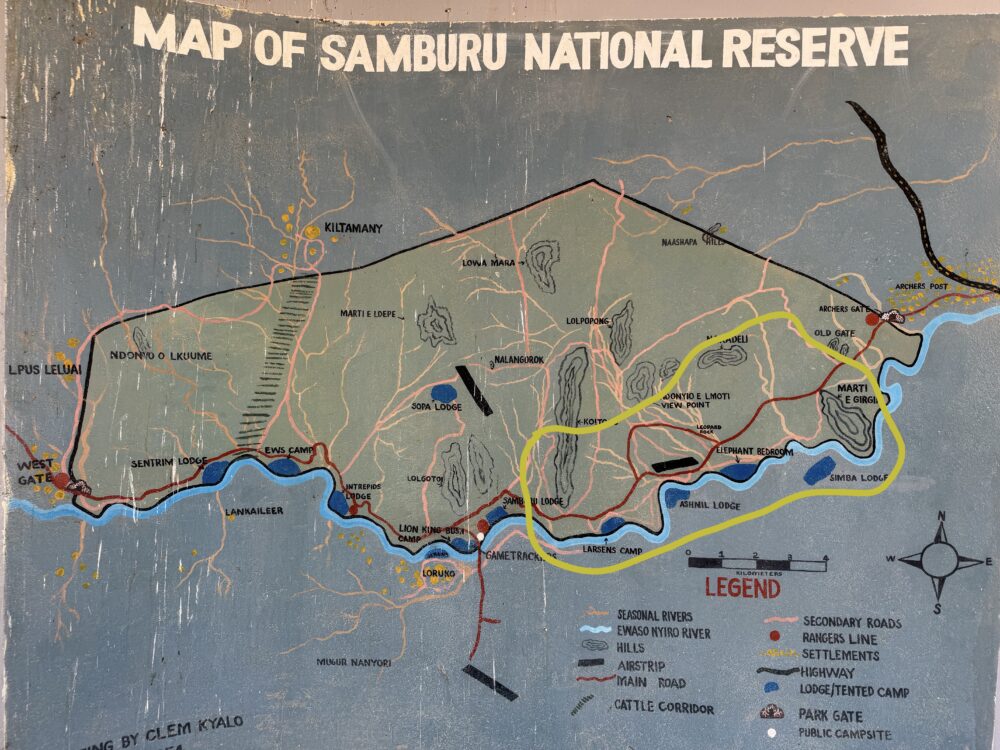
In Buffalo Springs, you’ll want to stay closer to the entrance, near the natural pool and river area.
In both parks, feel free to explore all the dirt paths and hug water during the warmer parts of the day. The BEST times to do game drives are at dawn and dusk when desert temps finally drop.
Read More: My Favorite Parks in East Africa for Wildlife
Common Wildlife Within the Parks
Both parks hold an abundance of wildlife and are optimal for the same species.
Let’s start with the Samburu Five
- Gerenuk
- Beisa Oryx
- Reticulated Giraffe
- Grevy’s Zebra
- Somali Ostrich
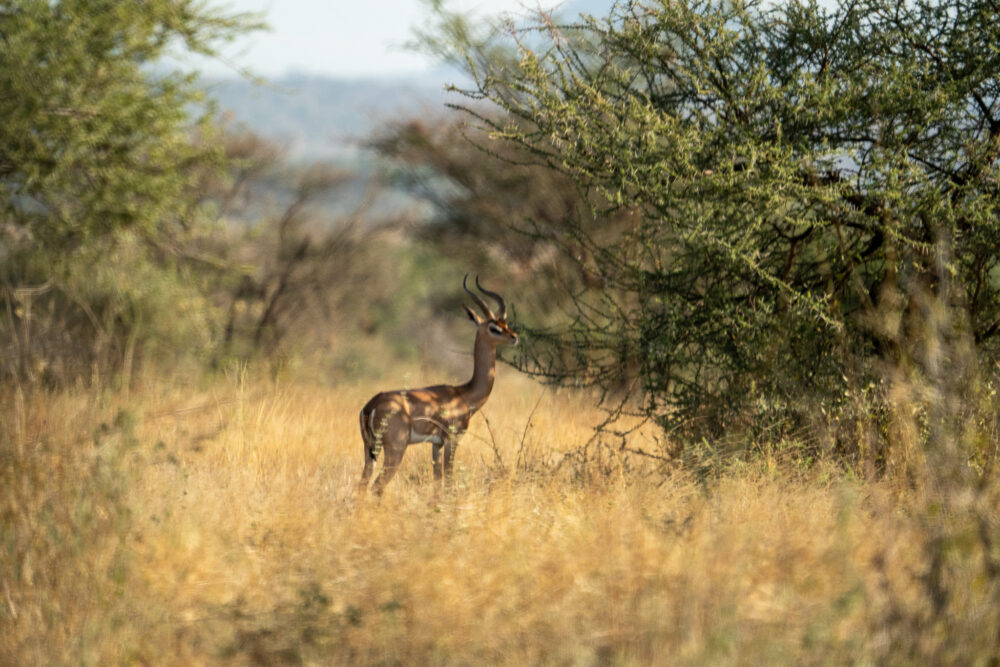

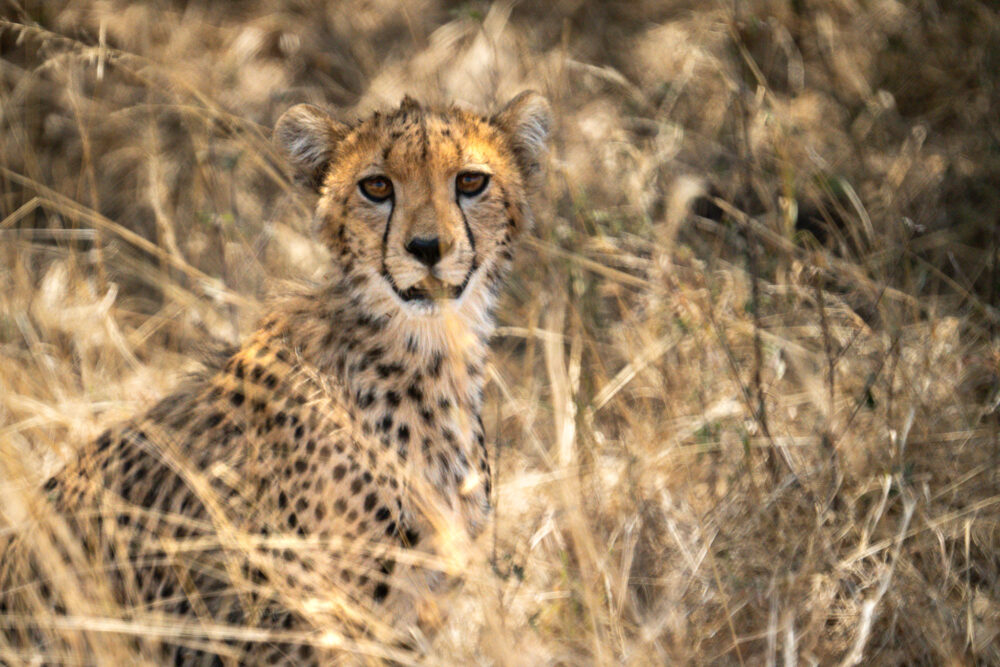
Then, some other fan favorites
- Lions
- Cheetah
- Elephant
- Impala
- Kori Bustard
- Secretary Bird
- Warthog
- Common Zebra
- Impala
- Dik Dik
- Vulturine Guinea Fowl


And a few rarely sighted animals
- Crocodile
- Hippo
- Leopard
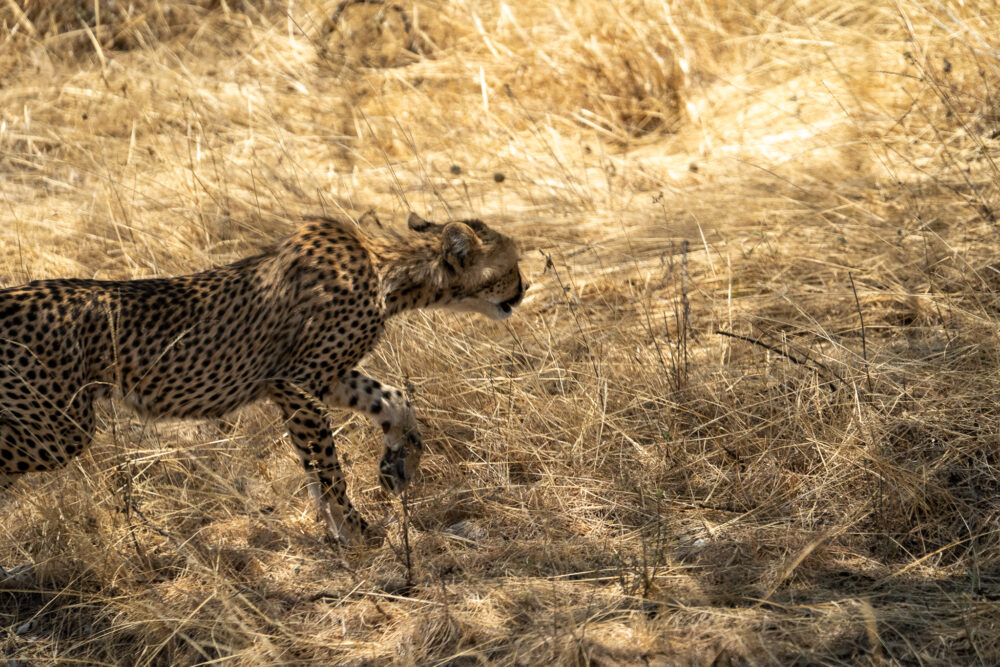
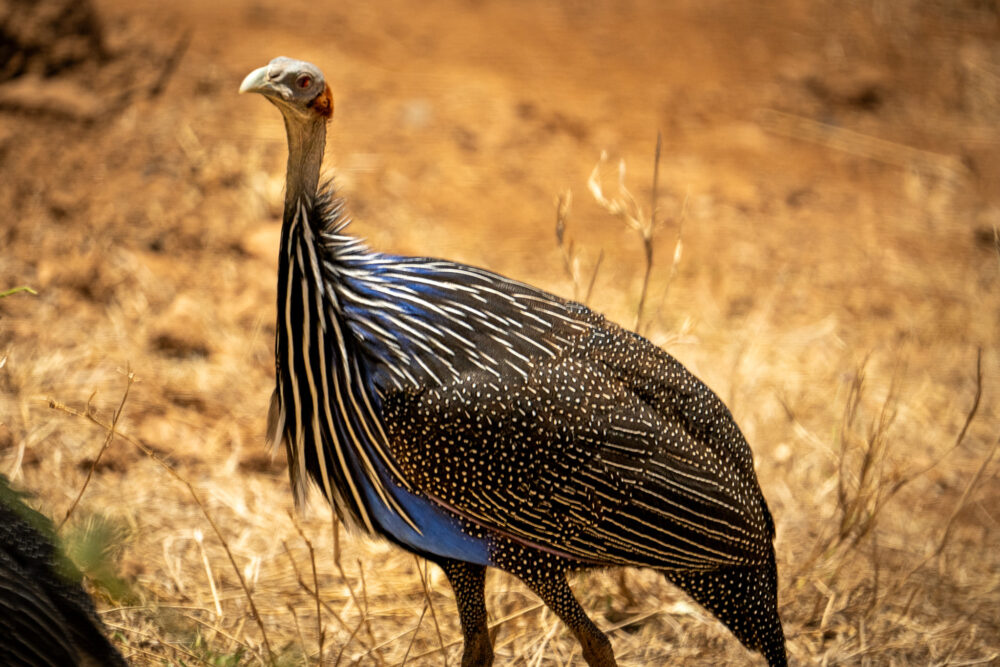
A Quick Guide to Archer’s Post
You might have seen me mention the town of Archer’s Post earlier in this guide. You will base yourself in this town before you enter the park.
It’s often considered the end of the line for road trippers as most car rental companies state this is the furthest North you can bring your car in Kenya. Beyond here, there are known to be territory disputes and internal conflict as you make your way toward Somalia.
There are basic groceries and small shacks selling gas of dubious quality in water bottles here to purchase in a pinch. No ATMs. Archer’s Post is quite small, so don’t expect a lot from it.
Where to Stay in Archer’s Post
Since the drive from Nairobi is long I recommend staying either the night before or after your foray into the parks at the Women’s Cooperative Campsite.

Your money goes to help support the local community, and the campsite is near the water with a soon-to-be-constructed restaurant on site. You can find the campsite clearly labeled on iOverlander, Maps.Me, and Organic Maps.
The Samburu People
I can’t write a blog post about Samburu National Park without discussing the Samburu PEOPLE. A semi-nomadic cattle and goat herding community with elegant dress and colorful elaborate bead necklaces that you’ll see all over the Archer’s Post area. This community has many similarities to the Maasai, and if you have time, you can visit one of the villages on the way into Samburu National Reserve by following the signs.
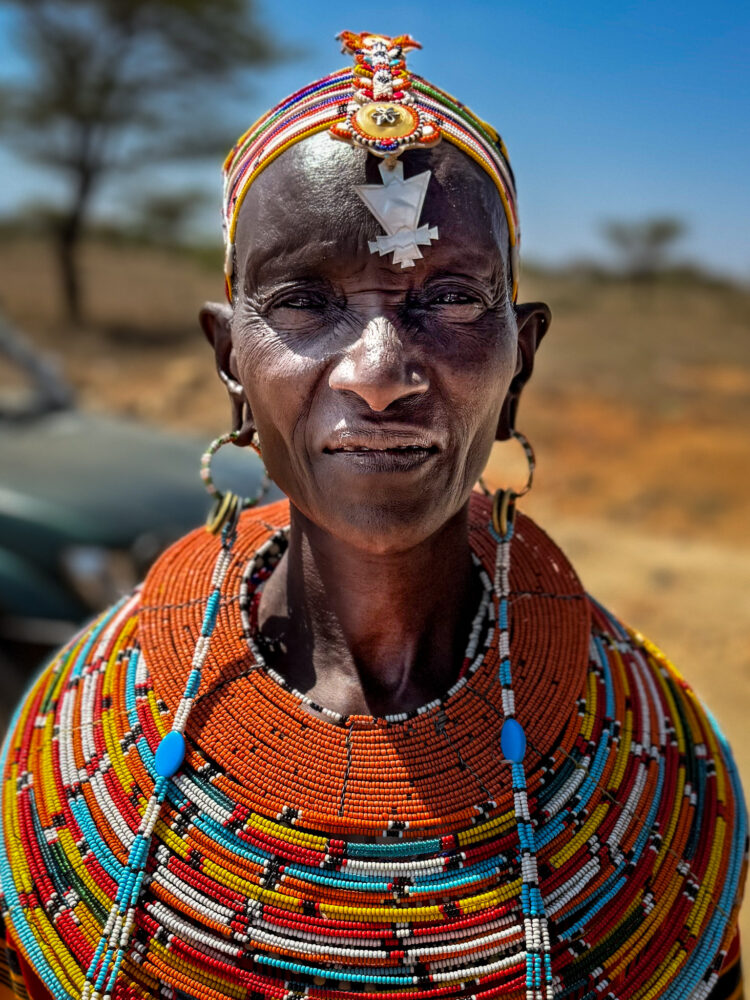
You’ll be encouraged to purchase their beaded designs on the roadside, and it can be a great way to support the local community and their traditional handicrafts. You’ll immediately notice that life is hard out there in the desert, and it’s a small way to give back to the place you’re visiting.
Read More: An Ethical Way to Visit Uganda’s Karamoya Tribe
Samburu and Buffalo Springs were two of our favorite reserves in Kenya because we saw so much unique wildlife without fighting for viewing spots! It’s a relatively untraversed region of Kenya and has a special ecosystem that is well worth adding to your itinerary.
Save This Guide to Samburu National Park for Later!







No Comments